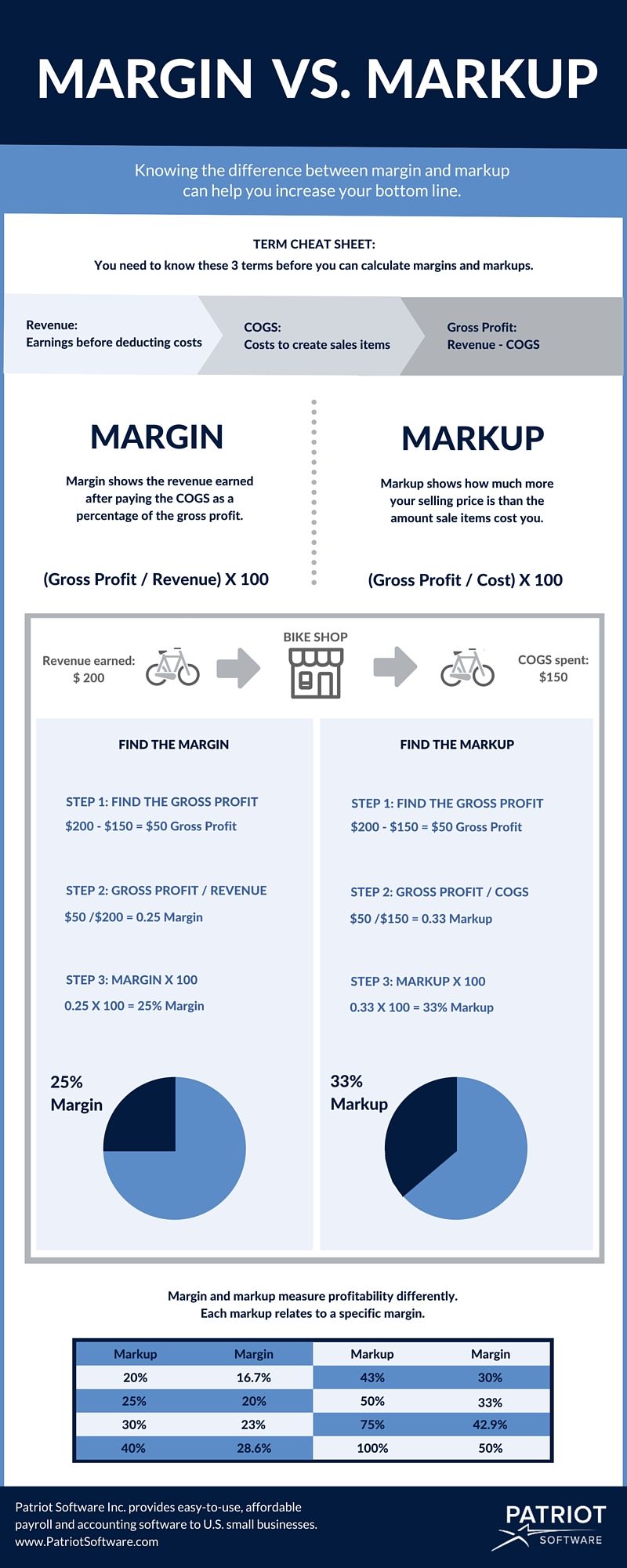Business owners often confuse margin and markup. Both figures help you set prices and measure productivity. But, a margin vs. markup chart shows that the two terms reflect profit differently.
It’s important to know the difference between margins and markups in accounting. Read on to learn about markup vs. margin. And, don’t forget to check out our infographic at the bottom of this page.
Terms to help understand margin and markup
To understand margin vs. markup, first know these three terms:
- Revenue
- Cost of goods sold (COGS)
- Gross profit
Revenue is the income you earn by selling your products and services. Revenue is the top line of your income statement and reflects earnings before deductions.
Cost of goods sold (COGS) includes the expenses that go into making your products and providing your services. Calculating COGS could include adding up materials and direct labor costs.
Gross profit is the revenue left over after you pay the expenses of making your products and providing your services. Gross profit is revenue minus COGS.
You will use these three terms when finding both margin and markup. Understanding the terms will help you grasp the difference between margin and markup.
Markup vs. margin
Calculating margin and markup is key to setting prices that not only cover your expenses but also leave you with a profit.
Learn the difference between margin vs. markup below.
How to calculate margin
A margin, or gross margin, shows the revenue you make after paying COGS. To calculate margin, start with your gross profit (Revenue – COGS). Then, find the percentage of the revenue that is gross profit. You can find the percentage of revenue that is gross profit by dividing your gross profit by revenue.
For example, you sell bicycles for $200 each. Each bicycle costs you $150. First, find your gross profit, or the difference between the revenue ($200) and the cost ($150).
$200 – $150 = $50 gross profit
To find the margin, divide gross profit by the revenue.
$50 / $200 = 0.25 margin
To make the margin a percentage, multiply the result by 100.
0.25 X 100 = 25% margin
The margin is 25%. That means you keep 25% of your total revenue. You spent the other 75% of your revenue on buying the bicycle.
The margin formula measures how much of every dollar in sales you keep after paying expenses. In the margin calculation example above, you keep $0.25 for every dollar you make. The greater the margin, the greater the percentage of revenue you keep when you make a sale.
How to calculate markup
Markups are different than margins. A markup shows how much more your selling price is than the amount the item costs you.
Like a margin, you start finding a markup with your gross profit (Revenue – COGS). Then, find the percentage of the COGS that is gross profit. You can find this percentage by dividing your gross profit by COGS.
Using the bicycle example from above, you sell each bicycle for $200. The bicycle costs you $150. First, find the gross profit.
$200 – $150 = $50 gross profit
To write the markup as a percentage, divide the gross profit by the COGS.
$50 / $150 = 0.33 markup
To make the markup a percentage, multiply the result by 100.
0.33 X 100 = 33% markup
The markup is 33%. That means you sold the bicycle for 33% more than the amount you paid for it.
The markup formula measures how much more you sell your items for than the amount you pay for them. In the markup example above, your markup is 33%. The higher the markup, the more revenue you keep when you make a sale.
Margin vs. markup chart
Margins and markups interact in a predictable way. Each markup relates to a specific margin, and vice versa. Markups are always higher than their corresponding margins.
To easily find the markups that correlate to margins, use this margin vs. markup chart:
| Markup | Margin |
|---|---|
| 15% | 13% |
| 20% | 16.7% |
| 25% | 20% |
| 30% | 23% |
| 33.3% | 25% |
| 40% | 28.6% |
| 43% | 30% |
| 50% | 33% |
| 75% | 42.9% |
| 100% | 50% |
Why margin vs. markup matters
Knowing the difference between a markup and a margin helps you set goals. If you know how much profit you want to make, you can set your prices accordingly using the margin vs. markup formulas.
If you don’t know your margins and markups, you might not know how to price a product or service correctly. This could cause you to miss out on revenue. Or, you might be asking too much, and many potential customers are not willing to pay your prices.
Check your margins and markups often to be sure you’re getting the most out of your strategic pricing.
Markup vs. margin: Ultimate infographic
Still need help with margin vs. markup? Check out our infographic to learn more.

Share this image on your site
Looking for a reliable way to keep track of all your small business’s finances? Patriot’s online accounting software is easy to use, yet powerful. And if you ever have questions, we offer free, U.S.-based support. Start your free trial today!
This article has been updated from its original publication date of July 14, 2016.
This is not intended as legal advice; for more information, please click here.
Leave a Reply